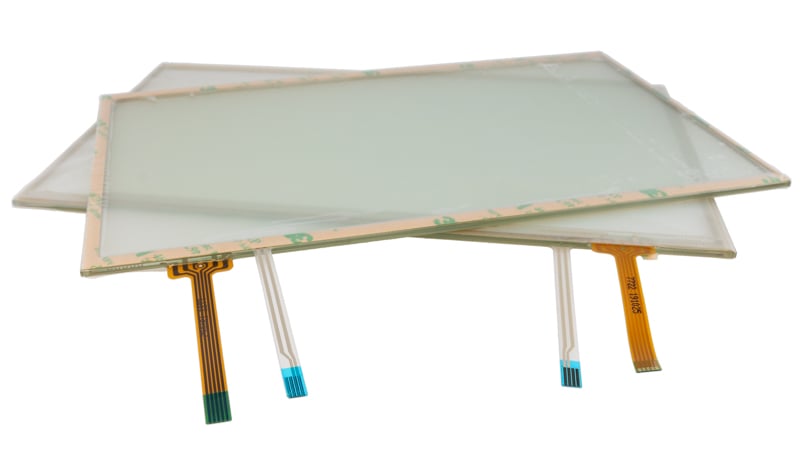Touchscreens are everywhere. From the coffee maker in the breakroom to the smartwatch on your child’s wrist to the in-flight entertainment system on your commuter flight, touchscreen technologies are a part of our everyday lives. As touchscreens continue to become intertwined in our culture, they help make everyday tasks that much simpler and improve the ease of use for all kinds of electronics.
For example, airport kiosks with fully integrated touchscreens have helped make checking luggage a painless process. After a few taps on an airplane’s GPS screen, a captain can enter new latitude and longitude coordinates. With a few swipes on a smartphone, a family member can send a 200-character text message. Touchscreens are used in nearly all industries including medical devices , military and aerospace equipment , industrial equipment , and consumer products .
For those that remember the days of T9 predictive text (which thanks to touchscreens is no longer required), creating text messages with a 9-button keypad was less than efficient. Looking further into the past, touchscreens developed in the 1980s were considered futuristic with only a handful of products available. Most were resistive style overlays that were paired with CRT monitors. These devices were bulky, wildly expensive, and offered limited functionality. The smartphone revolution of the late 2000s helped catapult touchscreens into our daily lives while driving down costs. Electronics owners are now able to interface with their devices faster, with fewer steps or taps, and with increased efficiency. Considering the net benefit to the User’s experience, many are willing to pay a premium for devices with touchscreens.
Surprisingly, custom touchscreen technologies can be quite affordable and a viable option for prototype manufacturing

ATMs are frequently designed with resistive touchscreen interfaces.
Resistive vs Capacitive Touchscreens
Touchscreens range in complexity and cost. The most common types of touch panels are resistive and capacitive touchscreens . While most touchscreens on the market today are the capacitive touch variety, this type requires specialty microcontrollers and firmware to integrate within the next higher assembly. Capacitive style touchscreens function by detecting a change in capacitance.
Capacitive touch displays are designed to respond to a human finger, a stylus, or another conductive instrument. One of the drawbacks to using capacitive touchscreens is that they seldom function with heavy gloves or electrically insulating mitts.
Resistive touchscreens can be operated with a simple calibration step and any instrument that can apply a point force to the screen. Resistive touch panels function no matter what type of gloves are worn by the user. They can successfully operate while covered in contaminants like dirt, salt deposits, and condensation. If the end-user is expected to be wearing heavy gloves, or the end application is especially dirty, resistive style touchscreens are a worthy solution and should be considered.
Resistive touch panels are available in a handful of different architectures, each with their own set of pros and cons. Of the three types of resistive touch panels (4-wire, 5-wire, and 8-wire), the 5-wire design is one of the most common and represents a high-performance and low-cost design solution. Epec recommends 5-wire designs when no specific design architecture is specified.
Resistive touch panels are comprised of glass and electrically conductive films separated by a small air gap. The touchscreen layers contain a transparent conductive coating, usually Indium Tin Oxide (ITO) that is deposited across the surface of the film. The panel is sectioned into quadrants, and each is electrically connected to a small flexible tail extending off one of the edges. This tail can be plugged directly into the mating control board for operation.
Resistive touchscreens function by applying a slight point force to the screen. When a finger or stylus touches the panel, a small amount of current is drawn to the contact point creating a voltage drop. The current flow from each quadrant is proportional to the distance to the location depressed on the screen. The location on the screen is then interpolated using a known algorithm that equates the measured resistance to a known calibration table.
Resistive Touchscreen Customization
With limited off-the-shelf choices for resistive touchscreens, designers should note custom production runs are a viable option when the required touchscreen solution cannot be found. When designed using readily available materials and processes, these devices can be extremely inexpensive and built within lead times comparable to circuit board assemblies.
Though many touchscreen overlays + LCD displays can be bought together as an off-the-shelf pair, the overlay can be designed separately from the LCD/LED/OLED display that they intend to be assembled with. Resistive touchscreens are matched to the size of the corresponding display. Custom-sized resistive touchscreens are common and straightforward designs as long as specs are available for the paired display. Custom touchscreens are manufactured from dimensional information on the LCD display’s datasheet. The information required to make a custom resistive touchscreen includes: the outline dimensions, the screen’s viewing area, and the touch-sense activation area. Custom resistive overlays can be produced in sizes of less than 3 inches, and larger than 21 inches. Most projects require a small non-recurring tooling expense to launch production.
Touchscreens are considered low voltage devices that typically operate at less than 5VDC and only milliamps of current. Customization measures can include adding anti-UV coatings, EMI shielding, and discrete components like LEDs or surface-mounted devices to the frame. The flexible tails used to connect the overlay to the primary PCBA are usually 1mm pitch Zero Insertion Force (ZIF) tails. The exact pin count, pin pitch, and ZIF tail stiffener geometries can be customized to the mating ZIF connector. Customers can specify their preferred board-mounted connector and Epec will develop a ZIF tail to properly match. To validate the design, Epec supplies a detailed manufacturing drawing that defines the pinout, dimensional information, and all performance requirements.

Custom manufactured resistive touchscreens with ZIF tail.
Summary
Considering that many electronics distributors carry standard-sized touchscreens in stock, buying a few for early prototyping is good engineering practice and can be accomplished for less than $50. Once the design is matured to a point where system requirements can be expanded, a full-service manufacturing partner like Epec can design and fabricate custom touchscreens to the exact size and level of function that the project demands.
Many of the design challenges that exist when considering touch overlays can be quickly remedied with a custom solution. Whether it’s extending the length of a ZIF tail, adding shielding, or reducing the activation area, touchscreen manufacturers like Epec can help drive risk out of the process. Starting that process early is always recommended, especially in times of global supply chain struggles.
Key Takeaways
- Resistive touchscreens offer low-cost and glove-friendly usability: Unlike capacitive screens, resistive touchscreens can be operated with any stylus, gloved hand, or even through dirt and moisture, making them ideal for rugged or industrial environments.
- Capacitive touchscreens are sleek but limited in versatility: Capacitive screens offer high responsiveness and are widely used in consumer electronics, but they struggle with gloved input and require specialized integration with controllers and firmware.
- 5-wire resistive designs strike a balance between cost and performance: Of the 4-wire, 5-wire, and 8-wire resistive options, 5-wire configurations are the most common and offer a reliable, budget-friendly solution that works well in many standard applications.
- Custom resistive touchscreen overlays are easy and affordable to design: When off-the-shelf options don’t meet size or functionality needs, custom overlays matched to specific displays can be produced with low tooling costs and fast turnaround times.
- Early engagement with a manufacturer streamlines integration: Customization like ZIF tail geometry, EMI shielding, or anti-UV coatings can be tailored to your assembly. Working with a full-service partner like Epec early in the process can reduce risk and speed up development.
















